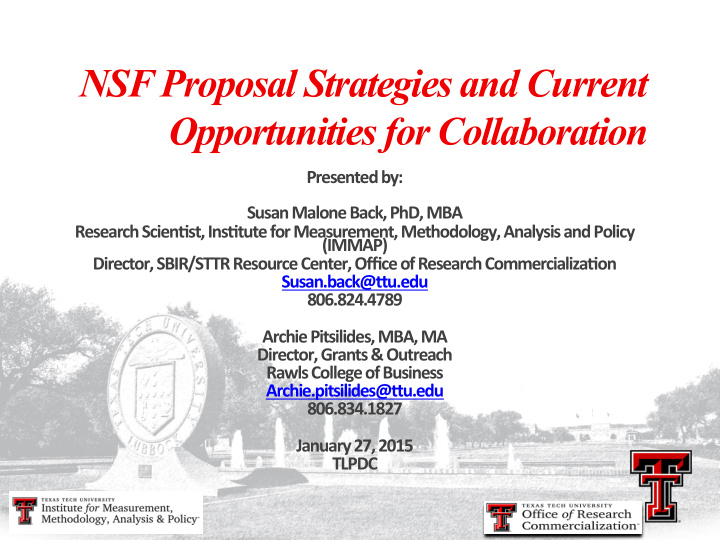



NSF Proposal Strategies and Current Opportunities for Collaboration Presented ¡by: ¡ ¡ Susan ¡Malone ¡Back, ¡PhD, ¡MBA ¡ Research ¡Scien;st, ¡Ins;tute ¡for ¡Measurement, ¡Methodology, ¡Analysis ¡and ¡Policy ¡ (IMMAP) ¡ Director, ¡SBIR/STTR ¡Resource ¡Center, ¡Office ¡of ¡Research ¡Commercializa;on ¡ Susan.back@Ju.edu ¡ 806.824.4789 ¡ ¡ Archie ¡Pitsilides, ¡MBA, ¡MA ¡ Director, ¡Grants ¡& ¡Outreach ¡ Rawls ¡College ¡of ¡Business ¡ Archie.pitsilides@Ju.edu ¡ 806.834.1827 ¡ ¡ January ¡27, ¡2015 ¡ TLPDC ¡
Sample Solicita;on ¡ “Research ¡Experiences ¡for ¡Teachers ¡(RET) ¡ ¡in ¡Engineering ¡and ¡Computer ¡Science” ¡ hJp://www.nsf.gov/funding/pgm_summ.jsp?pims_id=505170 ¡ ¡ ¡ “. ¡. ¡. ¡supports ¡ac;ve ¡long-‑term ¡collabora;ve ¡partnerships ¡between ¡K-‑12 ¡Science, ¡ Technology, ¡Engineering, ¡Computer ¡and ¡Informa;on ¡Science, ¡and ¡Mathema;cs ¡ (STEM) ¡teachers ¡and ¡community ¡college ¡and ¡university ¡faculty ¡and ¡students ¡to ¡ bring ¡knowledge ¡of ¡engineering ¡or ¡computer ¡and ¡informa;on ¡science ¡and ¡ engineering ¡as ¡well ¡as ¡technological ¡innova;on ¡to ¡pre-‑college/community ¡college ¡ classrooms. ¡The ¡goal ¡of ¡these ¡partnerships ¡is ¡to ¡enable ¡K-‑12 ¡STEM ¡teachers ¡and ¡ community ¡college ¡faculty ¡to ¡translate ¡their ¡research ¡experiences ¡and ¡new ¡ knowledge ¡gained ¡in ¡university ¡sefngs ¡into ¡their ¡classroom ¡ac;vi;es.” ¡
Overview of Today’s Program • A. ¡Merit ¡Review ¡Criteria ¡ ü Intellectual ¡Merit: ¡Poten;al ¡to ¡Advance ¡Knowledge ¡ ü Broader ¡Impacts: ¡Poten;al ¡Benefits ¡to ¡Society ¡ • B. ¡Objec;ves ¡ ü Project ¡Management ¡Objec;ves ¡ ü Outcome ¡Objec;ves ¡ • C. ¡Project ¡Evalua;on ¡ ü Forma've ¡and ¡Summa've ¡Measures ¡ • D. ¡Dissemina;on ¡
Broader ¡Impacts ¡: ¡Poten;al ¡Benefit ¡to ¡Society ¡ • Full ¡Par;cipa;on ¡of ¡Women, ¡Persons ¡with ¡Disabili;es, ¡and ¡Underrepresented ¡ Minori;es ¡in ¡STEM ¡ • ¡Improved ¡STEM ¡Educa;on ¡and ¡Educator ¡Development ¡at ¡Any ¡Level ¡ ¡ • Increased ¡Public ¡Scien;fic ¡Literacy ¡and ¡Public ¡Engagement ¡with ¡STEM ¡ • ¡Improved ¡Well-‑Being ¡of ¡Individuals ¡in ¡Society; ¡ • Development ¡of ¡a ¡Diverse, ¡Globally ¡Compe;;ve ¡STEM ¡Workforce ¡ ¡ • Increased ¡Partnerships ¡Between ¡Academia, ¡Industry, ¡and ¡Others ¡ ¡ • Improved ¡Na;onal ¡Security/Increased ¡Economic ¡Compe;;veness ¡of ¡U.S. ¡ • Enhanced ¡Infrastructure ¡for ¡Research ¡and ¡Educa;on ¡
Objectives • Project Management Objectives: ü Completion of Project Activities ü Creation of Materials (Testing Materials/Curriculum) ü Dissemination Activities • Outcome Objectives ü Cognitive: Knowledge/Skills/Problem Solving, etc. ü Affective: Motivation/ Self-Efficacy ü Cultural: Changes in Department/Institution/Profession • Activity 1: ü Write Project Management and Outcome Objectives
Project Evaluation • Evaluation Objectives ü Measure the progress and impacts of the project in achieving its goals, particularly the degree to which the participants have learned and their perspectives on science, engineering, or computer science have been expanded. ü Measure the impact on K-12 and community college students and their curricula.
Project Evaluation • Formative Measures ü Focus Group Analysis • Qualitative Assessment Tool – measure effectiveness of the delivery of the research experience ü Curriculum Enhancement Audit • Quantitative Assessment Tool – measure the number of new curriculum activities or teaching methods adopted
Project Evaluation • Summative Measures ü Exit Survey • Qualitative Assessment Tool – measure perceived quality of the delivered program. ü Classroom Experience Audit • Quantitative Assessment Tool – measure the number of undergraduate/ graduate classroom experiences.
Dissemination • Special Considerations ü Strongly encouraged • National audience • Free access to educators • Teach Engineering digital library (http://teachengineering.org)
Recommend
More recommend